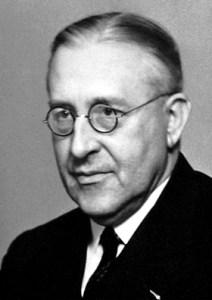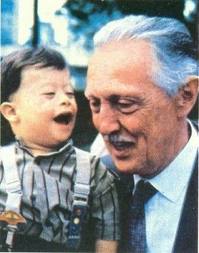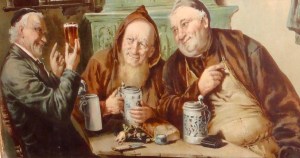We support our Publishers and Content Creators. You can view this story on their website by CLICKING HERE.
Real Faith, for a scientist, as for anyone else, is often a matter of bitter struggle. The victory must be won—or the gift must be discovered—by each one in his own soul.
One of the most famous scientists of the twentieth century is Edwin Hubble, after whom the famous Hubble Space Telescope is named. He is also known for Hubble’s law, which states that galaxies are moving away from the Earth at speeds proportional to their distance. In other words, the farther a galaxy is from the Earth the faster it will be moving away from the Earth.
This law, confirmed by observational evidence, shows that the universe is expanding, and it is one of the proofs for the Big Bang theory. When discussing Hubble’s law, physicists also use terms such as the Hubble constant and Hubble time. What is not as well known is that Hubble’s law was not really Hubble’s law, in the sense that it had already been proposed two years before Hubble had proposed it in 1929 by the Catholic priest and physicist, Monsignor Georges Lemaître (1894-1966).
It was not until 2018 that the International Astronomical Union finally voted to change the name of the Hubble law to the Hubble-Lemaître law in belated recognition of the priest-physicist’s pioneering contribution to cosmology and to the discovery of the Big Bang theory in particular. In finally singing Father Lemaître’s praises the scientific community was finally recognizing his largely unsung role. Even today, however, an internet search for “Hubble-Lemaître law” still redirects to the Wikipedia entry for “Hubble’s law.”
Although Fr. Lemaître’s contribution to science remained relatively unsung for far too long, it is nonetheless true that most Catholics who have an interest in science will have heard his name. The same is much less likely to be true of three other Catholic scientists of the twentieth century who deserve to be better known.
Victor F. Hess (1883-1964) was an Austrian-American physicist who was awarded the Nobel Prize in Physics in 1936 for his discovery of cosmic rays. Two years later, when the Nazis annexed Austria to the Third Reich, Hess emigrated from his native Austria to the United States with his Jewish wife. He accepted a position as Professor of Physics at Fordham University at which he taught until his retirement in 1958.
A devout Catholic, he wrote an article entitled “My Faith” in 1946, in which he professed the harmony that existed between his religious convictions and his work as a scientist. “A scientist, more than other scholars, spends his time observing nature. It is his task to help to unravel the mysteries of nature. He comes to marvel at these mysteries. Hence, it is not hard for a scientist to admire the greatness of the creator of nature. From this it is only a step to adore God.”
Recalling research that he was doing high in the Austrian Alps, 7000 feet above sea level, Hess wrote that “it was easy to feel oneself near to God” in the presence of such beauty. As for the research itself, it never caused any conflict with his religious beliefs. “I must confess that in all my years of research in physics and geophysics, I have never found one instance in which scientific discovery was in conflict with religious Faith.”
Nor, as a scientist, did he have any difficulty in believing in miracles. “Must a scientist doubt the reality of miracles? As a scientist, I answer emphatically: No. I can see no reason at all why Almighty God, Who created us and all things around us, should not suspend or change—if He finds it wise to do so—the natural, average course of events.”
Furthermore, Hess insisted that scientists were in need of a good religious education in the humanities as much as anyone else. “In regard to the deepest issues of mankind, scientists, like many others, are groping in the dark. Nevertheless, a good religious education, combined with scientific training, tends to give a scientist a better understanding both of nature and of human life.”
Gerty Cori (1896-1957), a Jewish convert to Catholicism, would be the first woman to win a Nobel Prize in Medicine, an award she received in 1947 for her role, along with her husband, Carl, in the “discovery of the course of the catalytic conversion of glycogen.” They were the third married couple to receive the Nobel Prize.
Born in Prague, Gerty Cori converted to Catholicism prior to her marriage in 1920. Two years later, she and her husband moved to the United States. In layman’s terms, their research revealed the mechanism by which glycogen, a starch made from glucose, breaks down into lactic acid in muscle tissue and is then resynthesized and stored as a source of energy. The discovery of this mechanism, known as the Cori cycle in their honor, constituted a major breakthrough in the understanding of carbohydrate metabolism. The Cori ester, which they identified, is also named after them.
Intriguingly, Carl and Gerty Cori’s only son married the daughter of the pioneering prolife and pro-family activist Phyllis Schlafly.
Continuing with the prolife connection,we will conclude with another scientist who is not as unsung as he was a few years ago. Jérôme Lejeune (1926-1994) was a French pediatrician and geneticist who discovered that Down syndrome was caused by an extra copy of chromosome 21.
A devout Catholic, he was horrified when his discovery began to be used to detect and exterminate children with Down syndrome in the womb. Confronted and affronted by the horrors of this systematic destruction of the unborn, Lejeune became a prolife advocate and activist.
In 1969, after giving a poorly received speech to fellow medical scientists in which he questioned the morality of abortion, he found himself increasingly ostracized. After the speech, he wrote in a letter to his wife, “Today I lost my Nobel prize in Medicine.” However wistfully he might have considered the loss of such worldly rewards, he was always motivated by the desire for the heavenly reward that good and faithful servants receive after death.
Following his election to the papacy, St. John Paul II invited Lejeune regularly to Rome to meet with him, desiring that he become the first president of the newly founded Pontifical Academy for Life. Lejeune drafted its bylaws and composed the oath of the Servants of Life which all members of the Academy would take. Being diagnosed with cancer, he only served for a few months as president of the Pontifical Academy for Life prior to his death in April 1994. Three years later, John Paul II visited Jérôme Lejeune’s grave.
On January 21, 2021, Pope Francis recognized Lejeune’s heroic virtue, declaring him Venerable.
Let us conclude this song of praise to four Catholic scientists with the words with which Hess ended his article on the relationship between his vocation as a scientist and his calling as a Catholic. Real Faith, for a scientist, as for anyone else, is often a matter of bitter struggle. The victory must be won—or the gift must be discovered—by each one in his own soul. It often takes the personal experience of grave danger of death to bring conviction and to prepare the way for Faith in Divine Providence. What is certain is that, when Faith comes, there follows a great serenity of soul and a deep peace in the human heart.
Republished with gracious permission from Crisis Magazine (April 2024).
This essay is part of a series, Unsung Heroes of Christendom.
The Imaginative Conservative applies the principle of appreciation to the discussion of culture and politics—we approach dialogue with magnanimity rather than with mere civility. Will you help us remain a refreshing oasis in the increasingly contentious arena of modern discourse? Please consider donating now.
The featured image is courtesy of Pixabay. The images of Georges Lemaître, Victor F. Hess, and Gerty Cori are in the public domain, courtesy of Wikimedia Commons. The image of Jérôme Lejeune, uploaded by Denis-Soto, is licensed under the Creative Commons Attribution-Share Alike 3.0 Unported license.

 Conservative
Conservative  Search
Search Trending
Trending Current News
Current News 








